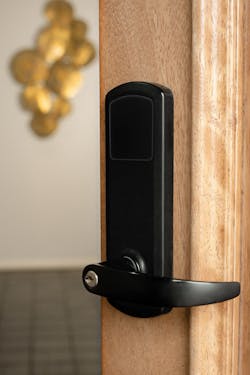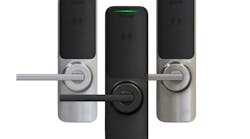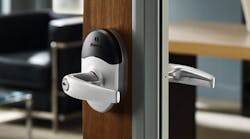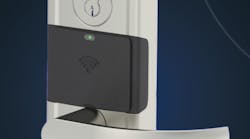When multiple technologies are combined and the combined technologies result in a solution that’s greater than the sum of the parts, it’s referred to as synergy. Wireless security technology is the product of the synergy among other technologies — better batteries, large-scale integration of circuitry, low power-draw components and wireless protocols.
For ages, with respect to electronic security, everything — power, access control, communications — was accomplished through wire. But now only the transmission of power remains wired for the most part. The other functions are being transitioned or are in the process of transitioning to wireless technology. (For this discussion, “wire” is defined as using a metallic conductor through which electrons flow. Many “wireless” locking solutions require connecting a cable between the device and a battery power source.)
In other words, wireless is replacing wire in the security industry as it has in computing and home-theater equipment.
In the security industry, intrusion alarms were one of the first product categories to be affected by wireless. Before the switch, the wire and the labor to install an alarm system took up most of the budget and time required. Residential alarm wiring typically was inside walls, and most intrusion protection was on exterior walls, which were the most difficult to snake wire through because of framing and insulation. Installers spent careers in attics, crawl spaces and on ladders. The industry saw the benefit of going wireless and made the change.
Locks were different, because for a long time, they didn’t even have wires. Many individuals who identified as locksmiths didn’t want to have anything to do with wires, and if a lock had wires, they didn’t want to be involved. Similarly, many technicians didn’t want to become involved with keys and locks.
Wireless technology became essential technology in the security industry, because it opened up opportunities for where security can be deployed, controlled and monitored — and by whom it can be installed. This permits far more effective life safety and security management.
Wireless technology also makes it possible to manage security hardware. Adding and deleting users, modifying time zones, setting up and modifying lock or unlock schedules, keeping activity logs and initiating real-time lockdowns are features that customers demand. And we can supply them thanks to wireless technology.
Wireless technology permits electronic locks to operate as stand-alone products while still providing the functions of connected wired locks, noted above.
Some argue that wireless technology creates more problems than it solves, but mechanical and electronic technologies now are necessary to fulfill important security system requirements adequately. When former Editor-in-Chief Gale Johnson would complain that a particular electronic product failed to live up to its promise, I’d remind him that regardless of whether the lock was mechanical or electronic, the more complicated the technology is, the more issues are to be expected in the training, deployment and performance of any lock.
Wireless Devices
Electric Strikes: Electric strikes were perhaps the first locking device that had wires. Providing power to electric strikes will continue to be via wire for the most part. However, ASSA ABLOY brand HES has released a wireless electric strike that shows promise in the industry. We’ll see whether others follow suit.
Door Locks: Electrified locksets — cylindrical and mortise — are elegant examples of electrified security. This product group has evolved into wireless thanks to servo motors that draw little power to operate, which makes battery power practical to the point where some locks don’t require a change in batteries for years under certain conditions.
Exit Devices: An exit device is traditionally a mechanical device, but exit devices have been integrated with features that require external power. Delayed egress and alarms are in wide use. Although most of these require wiring, electrified trim can use wireless technology to communicate with an access control system and batteries for power. Battery power, however, isn’t acceptable when egress might be prevented because of depleted batteries. Also, most locks used on fire doors and emergency exits are connected to the premises’ fire alarm and must unlock during an emergency situation.
Door Operators: These require more power than battery technologies are able to provide for full-time door operator duty cycles. However, there are door operators that regenerate their own power, and many door operators use wireless logic and control technology.
Intrusion Security Systems: We covered this. Hard-wired alarm systems are pretty much a thing of the past.
Video Surveillance: Additional nomenclature is necessary with respect to video surveillance.
- Wired video surveillance is used primarily on larger properties. As evidenced by the name, these systems require cables for power, internet connection and video transmission.
- Wireless video surveillance systems aim to address the most significant downside to a wired security camera system: installation. The key difference between a wired and wireless security camera system is that security footage is transmitted wirelessly from the camera to the recorder. External power is required.
- Wire-free video surveillance is the most flexible and easiest to install. Because of advances in battery technology, wire-free security cameras have evolved significantly and are a great security option.
Wireless Advances
By now, the names of wireless protocols, such as Bluetooth and Z-Wave, are familiar. Regardless of the particular protocol that’s used on a product, the features and benefits are similar.
The latest security solutions use smartphones for:
- Product setup and programming
- Cloud-based system administration
- Assigning mobile users
- Use as a mobile credential
Tim O’Leary is an experienced security consultant and a regular contributor to Locksmith Ledger.






